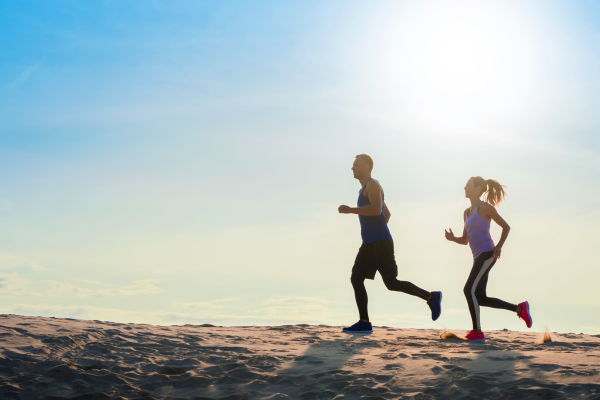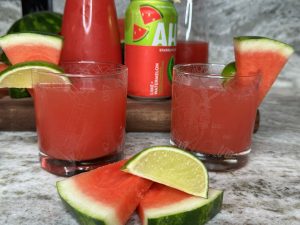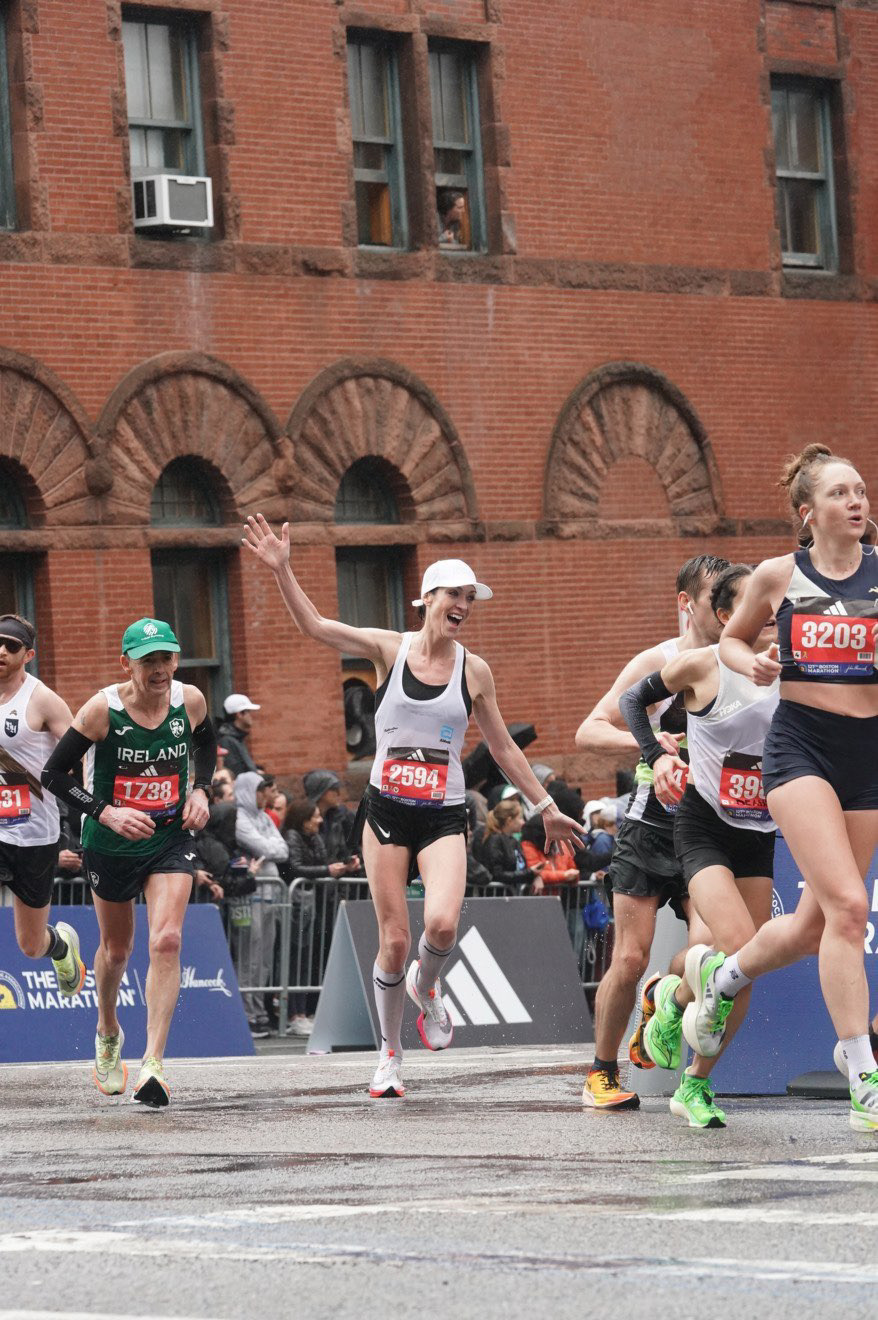How to Fuel to Feel Better During Summer Running
We’ve all had some rough runs in the summertime – whether you bonk, can’t hold your paces or feel awful for the day post-run. We cannot control the heat, humidity or dew point, but we can control the fluid, electrolytes and nutrition that we put into our bodies. Let’s discuss what we can do to support our bodies and feel better during summer running. (Note: Even when we do everything we can with hydration and nutrition, you may still need to adjust your paces or training plan due to the heat & humidity!)
What to do daily:
Hydrate
Stay on top of your hydration. You need to replace your losses from your runs/workouts + your baseline needs. This should be done before-during-after your run, while continuing to hydrate during the rest of the day.
Fuel
Yes, you need to surround your runs & workouts with solid nutrition, but please don’t forget solid daily nutrition. Often, the heat can decrease our appetite. If this is the case, be sure to schedule meals & not rely on appetite alone. Three meals per day, snacks when you need them, nail that protein, eat carbs.
What to do before your run:
Hydrate
Drink 8-16 oz of a sports drink 1-2 hours before your run to go into your run well-hydrated.
Fuel
Give your body the fuel it needs before your run. For runs <60 minutes, consume 25-30g carb before your run. For runs >60 minutes, increase your carb amount to 50-90+g carb (your weight in pounds divided by 2 equals the minimum grams of carbs you need). Add a little protein or fat with your carbs if you’d like.
What to do during your run:
Hydrate
Drink 10-24oz fluid per hour during your run. How much you drink will depend on your sweat rate. To calculate your sweat rate & learn more about how much fluid you need , check out our sweat rate calculator. Make sure that you are taking in enough electrolytes. Sweat composition is the amount of electrolytes lost in sweat. The more we sweat, the more electrolytes we lose and thus, need to replace. If you are not sure what your sweat composition is, a good place to start is a sports drink with moderate electrolytes (like Skratch Sport Hydration). If you are a heavy or salty sweater, you may need more electrolytes.
Fuel
For runs <60 minutes, you are probably ok without fuel during your run. If you feel like you need some extra energy – take a gel or some chews! For runs >60 minutes, you need 25-30g carb every 25-30min (about 60g carb per hour and up to 90g per hour for more seasoned runners & elite athletes). Don’t skimp on your fuel early in your run – as your heart rate and RPE increase later in your run, your tolerance for fuel may decrease.
After your run:
Hydrate
Rehydrate with fluid + electrolytes immediately post-run and for the rest of your day. Good options for replenishment are Skratch Sport Hydration, Liquid IV or your favorite sports drink. You can also replace losses with higher sodium food + water.
Fuel
Refueling your body will help with recovery and replenishment of glycogen stores. This will help you to feel better for the remainder of the day and ready for you next run or workout. Aim for 20-40g protein + 50g+ carbs within 60 minutes of your run. After long runs and workouts, it is preferable to consume all your protein + at least some carbs within 30 minutes and then the rest of your carbs within the next 60 minutes. Good options are refueling are Key Lime Pie Overnight Oats, EBTB Egg Sandwich, or High Protein Vegan Tacos(tip: you may need to add extra carbs to these recipes!)
Tip: If you struggle with lack of appetite after summer runs, try a shower shake (in your Featherstone Nutrition Blender Bottle) to get some nutrition in quickly and easily. Snacking on something salty like pretzels will also help to give you some electrolytes, increase your thirst and help with hydration.
Our hydration page has a lot of valuable hydration information and is a great place to start to dive into your hydration. If you need more help, we offer a Customized Fuel & Hydration Plan – please allow 14 business days to receive your plan (so order ahead of time!)
3 Fun Ways to Stay Hydrated this Summer
It’s hot. It’s humid. And we’re sweating. A lot. We’re on top of our hydration from reading through our Hydration Resource Page, and blogs on Hydration & Sweat Rate and Sweat Composition. Are you sick of thinking about your hydration? Here are some fun ways to increase your fluid & electrolyte consumption.
1. Add more foods with higher water content
Many healthy foods have a higher water content, and yes that counts toward your hydration goals! Try to add more of these foods to your meals and/or snacks to get some more water in there.
Veggies
Lettuce
Spinach
Cucumbers
Bell Peppers
Zucchini
Squash
Tomatoes
Celery
Fruit
Watermelon
Strawberries
Apples
Peaches
Honeydew
Cantelope
Oranges
Pineapple
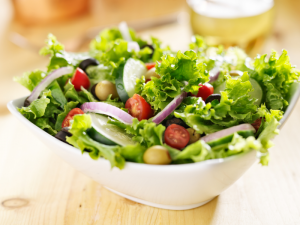
2. Try some new drinks
There are lots of drinks that can help with hydration besides a typical sports drink or water. Try something new & refreshing after a run & mix up your liquids throughout the day.
- Salty Watermelon Lime Spritzer
- AHA or other sparkling water
- Milk or milk alternative
- 100% fruit juice
- Coffee or iced coffee (in moderation)
- Coconut water
3. Have fun with your water
Your water doesn’t need to be boring. You can add ingredients to your water to mix it up. Here are some some tried & true combos that will bring some life to your water.
- Mint + Cucumber
- Mint + Lemon
- Lemon + Lime
- Strawberry + Lime
- Orange

What are your favorite drinks to stay hydrated in the summer?
Sweat Composition
Last week on the blog, we discussed hydration needs, sweat rate and how to use your sweat rate data to meet your hydration needs. Now, we’re on to the next level – sweat composition – why do we care about it, and how can we use our sweat composition data to improve our hydration & performance.
Why should I care about my sweat composition?
Sweat composition tells us the breakdown of electrolytes that we lose in our sweat. Our sweat contains water, sodium, chloride, potassium, and calcium. Sweat composition is genetic and it is fairly consistent throughout your training. Sodium is the electrolyte lost in the greatest amount via sweat, followed by chloride. Sodium losses & dehydration can lead to detrimental performance outcomes. The average athlete loses around 900 mg sodium per liter of sweat, with ranges from 200 mg – 2000 mg per liter reported. We also lose potassium, magnesium, and calcium in much smaller amounts, however, these electrolyte losses do not hinder performance & we typically consume adequate amounts in our daily diet. This is why we focus on sodium intake before, during, and after training and races.
Sweat composition varies dramatically as well. Understanding personal sweat composition has been a game-changer for many endurance athletes.
How do I know if I'm an average sweater or a heavy sweater?
Are you more sweaty than your running friends? Do you sweat through your clothes and look like you took a shower after every run? Then you might be a heavy sweater. As a general rule, if your sweat rate is >32 oz/hr, you are a heavy sweater (use our sweat rate calculator to figure out your sweat rate if you haven’t done so already).
How do I know if I'm a salty sweater?
Have you ever noticed white crusty stains on your clothing or gritty white residue on your skin after training? This is the salt in your sweat drying as the sweat evaporates. As your sweat dries, if you notice minimal salt on your skin and clothes you likely have a low sodium concentration in your sweat. If you notice some salt on your skin and clothes, you likely have an average sodium concentration in your sweat. If you see very noticeable lines on your clothing and skin, you likely have a very high sodium concentration in your sweat. Other signs, along with salty streaks, that indicate you may have a high sodium loss in sweat are frequent muscle cramps after heavy sweating, intolerance to training in the heat or feeling awful after, dizziness or lightheadedness at the end of training, your sweat stings your face and eyes, and cravings for salt. Salty sweaters may experience GI issues, cramping, decrease in performance, and intolerance to training in the heat more easily than peers.
How can I stay on top of my hydration as a salty sweater?
The CDC recommends that we eat less than 2300 mg sodium per day. A salty sweater loses this in an hour of running. As you can see, salty or heavy sweaters may need to add significantly more sodium into their day when training. It’s not uncommon for a heavy, salty sweater to need 2 – 4x the daily recommended amount of sodium. Add salt to your food. Try higher sodium electrolyte drinks. Choose saltier foods. And notice how you feel and recover.
In addition, salty sweaters training in the heat can benefit from taking a very high sodium supplement the night before big workouts and long workouts to hyperhydrate. This means our body holds onto extra sodium and fluid to act as a buffer to our hydration when we begin sweating in our next training session.
How do I know what my sweat composition is?
There are several options to help you determine your sweat composition:
#1 – Trial & Error
Use this post & our hydration resource page & think through if you have symptoms of a heavy or salty sweater. If so, try incorporating more sodium before/during/after runs and see how you feel. Adjust as needed.
#2 – Wearable Hydration Monitor
Calling all nutrition nerds/number nerds – this device is for you. With a wearable hydration monitor (like the hdrop), you will strap the device to your arm, complete your run or workout, and all the data will upload to the app on your mobile device. It will tell you how much sweat & sodium you lost and rates per hour. Super cool if you ask us. This device is also reusable. The Gen 2 just dropped – get it with our discount code here.
#3 – Hydration Sensor or Patch
Levelen is a patch you can wear and send back into the company, who will email your results of sweat loss & a breakdown of electrolytes lost (use code Featherstone for 20% off – order Single Sport for 1 use, Multi-sport for 2 uses). Nix is hydration sensor, in which fluid & total electrolyte loss (you will not receive a breakdown of each electrolyte just yet) will show up on the app after use. These options are not reusable, but you can order multiple patches.
If you need help with your fuel & hydration plan, Meghann can create a Customized Race Fuel & Hydration Plan for you! Plan ahead so you can practice your plan during your long runs -please allow 14 business days for your plan to be emailed to you.
What hydration & sports fuel products are right for me?
Find the right hydration and sports fuel products that will meet your hydration & fueling needs. Choose what you like and what you will consume. You can play around with hydration the night before, the day of, sports fuel, salt tabs/chews, etc. to find the right combination for you.
Hydration Products
Sports Fuel Products
Check out our Hydration resource page for more details on hydration, sweat rate & sweat rate calculator.
If you need help with your fuel & hydration plan, Meghann can create a Customized Race Fuel & Hydration Plan for you! Plan ahead so you can practice your plan during your long runs -please allow 14 business days for your plan to be emailed to you.
Disclaimer: The content in our blog articles provides generalized nutrition guidance. The information above may not apply to everyone. For personalized recommendations, please reach out to your sports dietitian. Individuals who may chose to implement nutrition changes agree that Featherstone Nutrition is not responsible for any injury, damage or loss related to those changes or participation.
Hydration & Sweat Rate
Hydration Needs for Runners
Hydration plays an important role in our performance and recovery as endurance athletes. Generally speaking, at baseline, women need 2.2L and men need 3L fluid per day. We also need to drink back whatever we sweat out. Understanding how much we sweat is important to nailing hydration.
Hydration & Performance
Dehydration can greatly impact your running performance because it causes reduced blood volume, increased HR, decreased skin & GI blood flow, increased core temp, and increased glycogen usage. Older research suggested anything over 2% dehydration decreased performance. However, a review of over 770 marathon runners found an average of 3.8% dehydration at the end of a marathon, with the range of 1.6 – 8% dehydration, with some of the faster runners ending the most dehydrated. This suggests we need to know our symptoms of dehydration and manage them accordingly.
Symptoms of dehydration while running:
- Decreased performance
- Inability to hold paces
- Fatigue
- GI distress
- Increased perceived exertion
- Muscle cramps
Sweat Rate
Average sweat rates for endurance athletes are 0.5 – 2.5 L/hr, and many runners sweat even more than this. Knowing YOUR sweat rate can be a game changer for staying on top of hydration in the heat. Test and re-test in different environments – so you know your sweat rate in the dead of winter vs. a hot & humid summer day. If you haven’t figured out your sweat rate yet, head over to our sweat rate calculator. You may be surprised by how much you sweat!
How to Use Your Sweat Rate Data
Before the Run
Start exercise well hydrated. This means recouping sweat losses from yesterday’s training.
Drink 8-16 oz fluid 1-2 hours before your run. Choose an electrolyte drink if it’s warm or you are a heavy/salty sweater.
Consider hyperhydrating the night before long runs if you are a heavy/salty sweater <something like Skratch Hyper Hydration can be helpful>.
During the Run
We will not and do not want to drink as much as we are sweating. We will end up dehydrated, but drinking minimizes the amount of dehydration to control the symptoms.
Drink 10 – 24 oz of fluid per hour during training over 60 minutes in the heat. Check out our Hydration page for more information on this.
In the heat, always drink an electrolyte drink or water with salt supplements for runs over 60 minutes. Drinking plain water is unlikely to meet your needs.
Consider sports fuel with more sodium if you are a heavy/salty sweater.
After the Run
Drink 16 – 24 oz of fluid ASAP post-run. Choose water + a salty snack or an electrolyte drink to rehydrate more quickly.
Drink enough to recoup your sweat losses to fully recover. For every 1 pound of body weight you lose while running <aka 16 oz> you have to drink back 20 oz to replace those sweat losses.
Next level: add up the fluid you took during your training. Subtract that from your training sweat loss. Drink that back in addition to your daily fluids throughout the day.
Rehydrate more quickly by drinking fluid with some carbohydrates and sodium. This can be in an electrolyte drink or food.
Examples
Runner #1 – Average sweat rate
Sweat loss
16 oz/hour, 19 oz total
Before
5 am – 8 oz Skratch Hydration
Run
6 am – 70 min EZ
During
8 oz Skratch Hydration + 1 serving Skratch chews
After
12-16 oz Skratch Hydration (+ daily requirements)
Runner #1 – Heavy sweat rate
Sweat loss
60 oz/hour, 70 oz total
Before
4:30-5 am – 16 oz Skratch Hydration
Run
6 am – 70 min EZ
During
24 oz Skratch Hydration+ 1 Never Second gel
After
24 oz Skratch Hydration + 24-36 oz water (+ daily requirements)
Check out our Hydration resource page for more details on hydration, sweat rate & sweat rate calculator.
Up next week on the blog – Sweat Composition – we will discuss the composition of your sweat, break down hydration and fueling products & how to put it all together to optimize your performance!
Disclaimer: The content in our blog articles provides generalized nutrition guidance. The information above may not apply to everyone. For personalized recommendations, please reach out to your sports dietitian. Individuals who may chose to implement nutrition changes agree that Featherstone Nutrition is not responsible for any injury, damage or loss related to those changes or participation.
Nutrition & The Menstrual Cycle
This post is for the ladies. We’ve all been there – cramps, bloating, fatigue…the list goes on with what we experience during our menstrual cycles. How can our nutrition support our bodies and lessen side effects in daily life and performance?
Nutrition for menstrual cycle side effects
Fatigue – Increased hormones and body temperature can disrupt sleep, contributing to fatigue. What can help? Don’t go to bed hungry or too full & eat enough throughout the day.
Bloating – This is one that I get questions about A LOT. Bloating occurs due to increased hormones. What can help? Keep exercising, hydrate well with the right amount of sodium, eat whole grains for fiber to keep your GI tract regular and fruits & veggies for potassium.
GI issues – Change in hormones can cause increased contractions in your GI tract. You may experience more GI issues on your runs or an urgent need to use the bathroom. What can help? Keep it simple when you eat before runs and the night before long runs <avoid high fiber and high fat foods>, and hydrate well.
Cramping – The first day of your cycle is usually the worst and then hormones that cause cramping will decrease. What can help? Omega-3s and magnesium may help.
Headaches – Often occur from constricting blood vessels during this time. What can help? Nitrates can help dilate blood vessels <think eating beets, spinach, other leafy greens, and watermelon>. Plus, make sure you are staying hydrated.
Nutrition during menstrual cycle phases
Follicular: Hormones are low after menstruation. We often feel stronger and are able to perform and recover our best here. Hydration is predictable and easier to maintain. The body cools itself more efficiently.
Nutrition Tips: Fuel during workouts + after. Hit those hard efforts – this is the best time to get after it!
Ovulation: Estrogen is high, and progesterone is low. With more inflammation, it may delay recovery from hard workouts. You also may not store carbs quite as efficiently, so stick a gel in your pocket for that run & rely on carbs to fuel you during runs.
Nutrition Tips: Eat before runs and fuel during all workouts over 60-70 minutes. Really nail that recovery meal and add some extra protein.
Luteal: Hormones are high. The body is less tolerant to heat because body temperature rises, the ability to cool ourselves during exercise is delayed, plasma blood volume is decreased and fluids in extracellular tissues increased. You may experience higher perceived exertion, a higher heart rate and take longer to recover.
Nutrition Tips: Focus on hydration – before a workout, you may need to hyperhydrate <more sodium & water> to increase plasma volume, listen to your body, and try to stay cool pre-workout. Increase your carbohydrate intake during runs. Increase recovery nutrition – carbs and protein. You may need to increase sodium in your diet by adding salt to foods.
Other considerations
Iron – Iron needs are higher for females with a menstrual cycle. You may need to supplement during your period, regularly or increase high iron foods in your diet. <Please reach out to a nutrition expert to help with this – do not blindly supplement!>
PMS Cravings – In order to reduce food cravings during PMS, eat enough during the day <3 meals + snacks>, nail your protein at all meals, and increase calories if needed to stay satiated.
Hunger – If you find yourself extra hungry the week before your period, there is a reason for that! Your resting energy expenditure increases, so allow yourself to eat more – add an extra serving of protein, veggies or whole grains at meals or add an extra snack in there.
PMID: 33572406, 34200767, 8303141
Disclaimer: The content in our blog articles provides generalized nutrition guidance. The information above may not apply to everyone. For personalized recommendations, please reach out to your sports dietitian. Individuals who may chose to implement nutrition changes agree that Featherstone Nutrition is not responsible for any injury, damage or loss related to those changes or participation.
Nutrition Mistakes That Runners Make
In all my years a sports dietitian, there are some nutrition mistakes that I see time and time again. Below are some of the most common nutrition mistakes I see and tips on how to avoid them.
Blaming GI issues on gels
This is a big one. So many runners experience GI issues <nausea, cramping, vomiting, diarrhea, etc> on runs and the first thing they do is blame their gels. While it is possible for gels to cause GI distress, gels are usually not to blame. So what should you look at first, before blaming your gels?
Food choices – the night before a long run <or sometimes the whole day before a long run> or what you eat pre-run. Are you eating too much fat or fiber?
Tip: Keep it simple. Easy to digest carbs and a little fat. The night before a long run, think white pasta with a little butter and parmesan instead of fettuccine Alfredo. For your pre-run snack, try a bagel instead of a donut.
Dehydration – if you aren’t adequately hydrated going into your run and/or get too dehydrated during your run, that creates less blood flow to your GI tract, which causes delayed gastric emptying, nausea, vomiting, pain and/or diarrhea. Where are my heavy/salty sweaters?? You will notice this first before average sweaters.
Tip: Know your sweat rate & sweat composition <free resource here>. Choose products to support your hydration needs pre, during, and after your run to avoid GI issues.
Practice fueling – Many runners don’t practice their race day fueling plan and then on race day, they expect their bodies to tolerate gels and sports drinks. You need to train your gut to be ready for race day.
Tip: Practice your race day fueling on your long runs. If you need help with your plan, we can build you a Customized Race Day Fuel & Hydration Plan!
Taking the wrong supplements
Antioxidants – More of a good thing is always better, right? Wrong. Mega doses of antioxidants can actually be harmful and can impair your body’s natural response to training.
Tip: Talk to your medical professional about which supplements you need.
Iron – I see many runners start iron supplements without checking labs because they are fatigued, not hitting paces, etc. This can be very dangerous – too much iron can cause another host of symptoms and be harmful to your heart and other organs.
Tip: Get your iron panel & ferritin checked and have a professional interpret the results and give recommendations <check out the Featherstone Lab Consult>.
Not eating before all runs <or other exercise>
Research has shown that when we fuel before exercise, we can train harder & recover faster. If we skip fueling, it can actually be harmful to our hormones and metabolism, as well as feeling worse during the run due to inadequate fuel availability.
Tip: Eat 25g carbs before runs <60 minutes & 50g+ for runs >60 minutes. Find some ideas here.
Eating the wrong foods pre/post run
Macronutrients <carbs, protein, fat> each have a role in your daily and performance nutrition – knowing when to consume each to support our training is important. Focus on carbs pre-run for quick fuel, and then after your run, protein <to stop muscle breakdown and repair muscles> AND carbs <to aid in recovery and replace glycogen>. Fat should be added in throughout meals & snacks but avoid large amounts in your pre-run meal or snack.
Tip: Pre-run = carbs, post-run = protein + carbs <and fat anytime except pre-run>
Saving calories for the end of the day
So many people <especially Americans> save calories for the end of the day to eat “whatever they want”. Your body doesn’t like this. Saving calories for the end of the day can result in undesired body composition, overeating, not seeing expected gains in fitness and can contribute to an unhealthy relationship with food. We want to surround our runs and workouts with solid nutrition, so we can get the best out of our training and recover well. We also want to eat 3 solid meals per day <carbs, protein, fat and color>.
Tip: Surround your runs and workouts with solid nutrition <pre and post>, eat 3 meals per day, eat snacks if you need them, nail protein at all meals.
Trying all the fad diets
No fad diet is going to fix poor nutrition habits. There are no shortcuts. You put in the time to train hard day in and day out, so why not provide your body with the fuel that it wants and needs?
Tip: Just say no to fad diets. Focus on supportive nutrition for your daily life & performance.
PMID: 2287256, 25429252
Disclaimer: The content in our blog articles provides generalized nutrition guidance. The information above may not apply to everyone. For personalized recommendations, please reach out to your sports dietitian. Individuals who may chose to implement nutrition changes agree that Featherstone Nutrition is not responsible for any injury, damage or loss related to those changes or participation.
The Problem with Counting Calories
On the heels of last week’s blog post, weight loss & running, let’s talk about calories. We get tons of questions asking how many calories to eat. We all know runners <or were that runner> following 1,200 calorie weight-loss diets while trying to train. Or, thinking we should consistently eat 2,000 calories a day not thinking about the running mileage that is piling up each week. There’s a lot of misinformation out there, and there may be factors you haven’t considered when it comes to determining your calorie needs. Let’s take a look into calories together.
The Problem with Counting Calories
Calories are a unit of energy and come from carbohydrates, protein, fat & alcohol. Last week, we discussed the main principle behind weight loss, you need to expend more energy than you consume (calories out > calories in). But, it’s not that simple. It’s actually very complex. There are LOTS of ways that we can under or overestimate calories & plenty of ways our body can adjust how many calories it needs for different activities if we under-fuel it long enough.
Calories In
Did you know that nutrition facts labels can be off 20% and still be considered accurate? That margin of error means the difference in 200 calories vs. 240 calories in a serving of your favorite snack. Multiply that by X foods that you eat in a day, and you can be looking at hundreds of calories different from what you thought you were eating. There’s also human error in estimation. As a whole, humans usually underestimate portion sizes and overestimate calories burned through exercise, leading to much less of an energy deficit (if any deficit at all).
Calories Out
There are many factors that determine how many calories you burn in a day, including heart rate, body temperature, weight, hormones, body composition, exercise & NEAT (non-exercise activity thermogenesis aka activities of daily living). These factors vary by individual and some change on a day-to-day basis. We know that extreme caloric restrictions, large intra-day energy deficits, hormone changes, excessive stress or exercise, and lack of sleep can change our body’s calorie burn through all of these factors.
But can't my smart watch accurately estimate my calories out?
Smartwatches estimate calories burned based on heart rate, however, the estimations can vary greatly between different brands of watches, the temperature outside, cadence lock, etc. The number you see is truly an estimation, and you should not rely on this for accuracy.
Calories for runners
Most Americans have heard of the recommendation to consume 2,000 calories per day for an adult. This number was determined by the FDA (Food & Drug Administration) as a standard for the average adult. It might be a good place to start for some people but varies based on height, sex, weight, activity level, etc. As runners, we are not the average American. We are asking our bodies to perform at a high level, requiring more energy. Calorie needs for runners can range from 1800 – 4000+ calories per day.
Does timing matter?
The average American has a very calorie-heavy back-end of their day (i.e. little to no breakfast & lunch and then eats a large dinner & snacks at night). If you remember from last week – any periods during the day with large calorie deficits actually have negative consequences for men & women. There are certainly better ways to time your nutrition and distribute your calories throughout the day. Balancing your nutrition intake throughout the day and surrounding exercise with supportive nutrition is best for body composition, performance, recovery and injury prevention. Give your body what it needs, when it needs it. Do not ‘save’ calories for dinner & beyond, especially if you are running, lifting, or cross training in the mornings.
Mental health considerations
Counting calories or tracking nutrition may work for some people, while it can be detrimental to others. Or, what may start out as helpful accountability & self-education can turn into unhelpful or even harmful to your mental health, and thus, your performance. Counting calories can lead to an obsession with numbers and restriction. That is why I generally recommend NOT focusing on calories. There are other ways we can get the right amount of nutrition to support your daily life & performance goals.
Shift your mindset
Instead of focusing on calories, think about supporting your body for daily life & performance. Your meals should have a balance of protein, carbohydrates, healthy fat, and color. This balance will help keep you satiated and support your performance goals. You should surround your exercise with solid nutrition to provide fuel for the work you are doing & for recovery. Once you start to make this shift, great things will happen!
How do I know if I'm eating the right amount of calories?
You are eating 3 meals per day + snacks if you need them
Your meals are balanced with carbs, protein, healthy fat & color
You are fueling before + after exercise
You are nailing your protein at all meals
You aren’t binging in the afternoon/evening
You aren’t starving at any point in the day
You aren’t overly full after meals
You aren’t waking up at night hungry
You feel good and well-fueled during exercise
If you need help moving away from calorie counting & focusing on supportive nutrition for your daily life & performance, complete a coaching application to work with Meghann!
PMID: 29205517, 29405793
Disclaimer: The content in our blog articles provides generalized nutrition guidance. The information above may not apply to everyone. For personalized recommendations, please reach out to your sports dietitian. Individuals who may chose to implement nutrition changes agree that Featherstone Nutrition is not responsible for any injury, damage or loss related to those changes or participation.
Weight Loss & Running
Raise your hand if you started running to lose weight and then fell in love with running? That’s how so many of us runners got our start. But, as we increase mileage, add race goals, and try to continue to lose weight – this can get tricky.
When is it appropriate to try to lose weight while running and how do we do it safely and make sure it does not impact our performance and overall health & injury risk?
The basics
In order to lose weight, you must burn more calories than you take in (calories out > calories in). This sounds simple, but there are so many other factors that make this much less simple, such as changes in resting energy expenditure, genetics, daily habits, food choices, etc. For these reasons, a weight loss journey will look different for everyone.
Set your priorities
First and foremost, ask yourself. ‘Am I trying to fuel for performance or for weight loss?’ These two goals are competitive. If we try to have it all for too long, we increase our risk of injury, burnout, and low energy availability + all the consequences that come along with it. Undercutting nutrition for weight loss is in direct competition with performance. When we consistently under fuel for weight loss, we are not supporting optimal performance in workouts and we sure as heck are not supporting recovery. Think about it – as mileage increases, we need more energy. If you do not eat to support your energy demands of training, you won’t hit paces in workouts. You won’t recover well. You will not replete glycogen stores. You will likely feel fatigued, sore, irritable and performance suffers. So, if you are in a training cycle, do not cut your energy intake to try to lose weight. Focus on your training, fuel like a boss, and if you’d like to revisit weight loss after your race, go for it!
How to lose weight safely
The safest and most sustainable way to lose weight is to surround your runs and workouts with solid nutrition. Nail your pre-run snack, fuel runs over 70 minutes, and rock that recovery nutrition. Then, skim a small energy deficit across your day. We’re talking small tweaks across the day at each meal and snack. We are not talking about skipping meals and snacks. We do not want large energy deficits during the day. Research has shown that women who cut more than 300 calories per day can experience menstrual disturbances, amenorrhea, lower metabolism, higher cortisol, and lower hormone levels. Men who cut out more than 400 calories per day were more likely to have lower testosterone, lower metabolism, and greater muscle breakdown.
Control your hunger
Hunger is the enemy of weight loss. Controlling hunger is key. If we skimp too much and are ravenous at 2 pm, we will face plant in all the snacks, and overeat later in the day or on the weekends. If you are starting to get hungry… eat something! The best way to stay satiated is to eat balanced meals and snacks. Protein, healthy fats, and fiber will help keep you full longer, so make sure to include one or more at all eating occasions.
Example Day for Weight Loss:
5am Pre-run snack – banana
5:30am Run
7am Recovery meal – EBTB Egg Sandwich + extra egg whites + berries.
10am Snack – Snickerdoodle blender muffin
12pm Lunch – Salad w/grilled chicken + whole grain roll (choose a light balsamic vinaigrette instead of ranch)
3pm Snack – Apples with peanut butter (choose half the peanut butter than normal – 1 Tbsp vs. 2 Tbsp)
6:30pm – Spaghetti pad thai
Skimmed about 200 calories with 2 small changes
This is just one example and will not look the same for everyone. Reach out for individualized recommendations specific to your unique needs.
Sources: PMID: 29205517, PMID: 29405793
If you want to learn more from Meghann, check out our virtual Off-Season Body Composition Series!
Disclaimer: The content in our blog articles provides generalized nutrition guidance. The information above may not apply to everyone. For personalized recommendations, please reach out to your sports dietitian. Individuals who may chose to implement nutrition changes agree that Featherstone Nutrition is not responsible for any injury, damage or loss related to those changes or participation.
What Might be Causing GI Distress on Race Day
It’s no fun. It can feel awful. But many of us runners have been there – having GI distress on race day. We work so hard to train and then get to race day and might experience nausea, vomiting, diarrhea and cramping. What gives? There are many reasons why we might experience GI issues on race day, and we will discuss some of the reasons that I see most with clients who come to me looking for help. Take a look below to see what might be causing your race day GI upset and what you can do to avoid it.
The Food You've Consumed in Previous Days
If you know me <The Bagel Queen>, you know that I strongly encourage carb loading before race day. Carb loads can be 1-3 days <or more in some cases>, and the goal of a carb load is to increase your carb intake <check out our carb load calculator> to stock your glycogen stores for race day.
If you are a newbie carb loader, or are unaware of how other ingredients in those foods might affect you, you may need some help choosing your carb-tastic foods.
Early in the carb load you may be able to tolerate more fiber and/or fat in those foods <whole grain bread, veggies, and fruit> you may want to start to choose lower fat & lower fiber foods as you get closer to race day. Simple carbohydrates that are low in fiber and fat <white bread, white bagels, pretzels, juice, etc> will help decrease the risk of GI distress on race day. Although, I do have some athletes who have guts of steel that can tolerate all the different foods pre-race, many of us need to be intentional about what foods we consume in larger quantities.
What you can do: Choose low fiber & low fat foods in the 1-3 days leading up to your race.
Dehydration
One of the biggest issues I see causing my client’s GI distress is dehydration. Dehydration can be caused by going into a run dehydrated, not drinking enough fluid during runs, and/or not consuming adequate sodium. If you are a race-day water-only drinker, you may need to consume more electrolytes. If you are a heavy and/or salty sweater, you may need much more fluid and sodium than you think.
Knowing your sweat rate <amount of sweat per hour> and sweat composition <amount of electrolytes in your sweat> will help you understand what your needs are in order to create a race day hydration plan that works for you. Head over to our Hydration page for more information & a general place to start.
What you can do: Start exercise well-hydrated and look into your sweat rate & sweat composition to help meet your hydration needs <we love the hDrop wearable hydration monitor!>
Sport Drink & Fuel Concentration
Your choice of race-day fuel & sports drinks can contribute to GI distress on race-day if you aren’t taking them properly. Too much sugar in your GI tract without adequate liquid can cause nausea, cramping, and diarrhea. Most gels require 2-4 oz of water or sports drink to be consumed at the same time to aid in digestion and absorption. Some newer gels <Maurten, Never Second> do not require fluid, due to their specific formulations.
You also want to make sure that you mix your drinks carefully to avoid over-concentrating. Some sports drinks are now made with certain carbohydrates that are able to be concentrated in higher amounts without causing GI distress <like Skratch Clear Hydration>.
We used to think that gels had to be taken strictly with water, but newer research has shown that it’s ok to mix some types of gels & sports drinks, depending on carbohydrate concentration and osmolality.
What you can do: Know if you need fluid with your gels & mix sports drinks according to the instructions, trial & error, and practice.

Core Body Temperature
When core body temperature increases, your body will pull blood flow away from your gut & muscles to cool the skin, which decreases gastric emptying and absorption of nutrients. Core body temperature will likely increase as the length of your endurance race increases – so that’s one of the reasons why I recommend to front-load your nutrition <get it in while you can>. Core body temp will also rise with increased temperature and humidity.
What you can do: dress appropriately for the weather, hydrate well, front load nutrition, ice or cool water in your hat, or down your shirt to keep you cool.
Rate of Perceived Exertion
As your rate of perceived exertion (RPE) increases, gastric emptying and absorption of nutrition decreases. Most times, you will feel this later in a race, but sometimes, depending on other factors <temperature, wind, illness, etc.> this might be an issue from the start line. Know your body and know if you need to slow it down for the race to keep RPE lower. This is another big reason that I suggest front-loading your nutrition & carb loading – fuel when you can so you have stores left at the end to fuel your race if you are unable to take in more gels.
What you can do: be aware of your RPE and adjust pace if needed, front load nutrition, and practice your race day fueling & hydration plan during training.
Sources: PMID: 2287256, 28919842, 25997181, 17465596
If you need help figuring out what is causing your race day GI issues, apply for 1-on-1 nutrition coaching or Last Minute Crunch Time Session with Meghann here.
Disclaimer: The content in our blog articles provides generalized nutrition guidance. The information above may not apply to everyone. For personalized recommendations, please reach out to your sports dietitian. Individuals who may chose to implement nutrition changes agree that Featherstone Nutrition is not responsible for any injury, damage or loss related to those changes or participation.
Meghann's Boston Race Recap
The Boston freaking Marathon. We all know it. We all love it. We all want to run it. Well, just like the rest of my race recap below, this is my experience. There will never be a year I ‘don’t want to’ run it. There will always be lessons learned. And, there will always be a way to improve our performance out there.
So, at so many of your requests, here it is… my Boston Marathon recap.
<<and, I think we all know this is my experience – this is not how you have to do it – and this is not a substitute to working on your marathon fueling with a sports dietitian.>>
The Carb Load
We all know the party don’t start till I <<re: bagels>> walk in. Race day weekend always starts three days out when the carb load begins. We know that increasing our carbohydrate intake before a race stocks our fast fuel source, glycogen, in our muscles. A full carb load can absolutely save the day out there and allow you to finish your race feeling physically and mentally strong. And, I dunno about you – but a smile down Boylston St is an absolute must in my Boston experience.
FRIDAY – Day One
The carb load started on Friday as I traveled into Boston on an early flight. I was up at 3:45 am eating grahams + chugging coffee so I didn’t fall asleep at the wheel on the way to the airport. Once I got to the airport, I drank a Liquid IV <team watermelon> and ate a Rise protein bar <Use code Feathers10> + Skratch Labs Crispy Rice Cake <team strawberry> as I waited to board. On the plane, I finished a new client plan & stalked my panel guests, Joan Benoit Samuelson & Pam Bede, to make sure I knew everything I needed about them and was ready to moderate the Expo panel with Abbott as our sponsor.
Once I landed, my driver said traffic was horrible and something happened in the tunnel so emergency Skratch Labs Crispy Rice Cake to the rescue. Everyone listen up! This is why I always tell you to pack emergency snacks in your carry on when traveling during a carb load. The driver also had some water for me which was clutch. At the hotel, the bagel load commenced as there was a half dozen waiting for me in my room. Lunch consisted of a bagel + peanut butter + Greek yogurt. There was a bagel snack in there somewhere. And, I ate a bagel + another Rise protein bar before we headed to dinner. Well, dinner turned out to be more of an open bar and less of the high carb foods I was looking to devour. So, when I got home at 9 pm you guessed it another bagel + peanut butter + Skratch Wellness as a night cap.
Friday’s Bagel Total: 4
Friday’s Carb Intake: 450 gm

SATURDAY – Day Two
We woke up early Saturday to make our way over to film the infamous Carb Load boxes at New Balance before you all came and ate them all! This meant coffee + grahams in the hotel at 5:30 am. <If it ain’t broke… stick to familiar things during your carb load. This is what I do every stinking morning of training.> When we arrived at New Balance, there were 1000 fresh bagels waiting for us. Legit I thought I was dead & in heaven. So, we of course had to sample one, approved! After we wrapped up our event, we all had another bagel because clearly, we couldn’t let these go to waste – fill up that glycogen tank!
I went back to the hotel and feasted on some of the Carb Load box goodies, graham crackers & animal crackers. I forgot how freaking delicious those Barnum boxes of animal crackers are. Then, I went out to lunch with the Believe in the Run team + Emily Saul <fabulous Sport Psychology Coach>. And, when we ordered I might have slightly frozen and also picked a bagel & cream cheese here. <Clearly you cannot teach an old dog new tricks.> Emily helped me visualize better downhill running tactics so I didn’t squeeze the hand break & heal strike the entire first 7 miles like last year.
At this point, I had one small gig to film & then I could rest my Saturday away in a quiet hotel room without hearing ‘Mom’ 1200x per minute. You are all the kindest & many of you reached out worried about my lineup before a goal race – but let me tell you, being able to drop the ‘Mom’ title for the weekend meant this felt like a laid-back vacation. <Shout out to all the other working parents trying to balance parenting, kids, work, training, & making it look easy – it ain’t.> While catching up on trash TV, I decided to play around with my nutrition choices and see how it impacted my blood glucose. I came to Boston with Abbott and had the opportunity to wear their Glucose Sport Biosensor and have been able to see a minute-by-minute read of my blood sugar throughout the carb load. <nerd alert: fascinating! Disclaimer: I am using this device to gain knowledge on how I can improve my running performance with this biosensor. TBD for more…> As expected, my blood glucose rose quickly after eating bagels, grahams, and animal crackers – as it should. More refined, lower-fiber carbohydrates will do that. But, I’ve got a healthy pancreas, like most of us, so it quickly came right back down into range. These increases in blood glucose are what trigger the storage of carbs as glycogen, aka the goal of this carb load. But, I was curious – what would happen if I ate a high-protein Greek yogurt before eating bagels? This was my chance. So, for dinner, I ate a Greek yogurt and followed it up with 2 bagels + some peanut butter. In theory, the protein and fat should have kept my blood glucose from climbing as high as eating a bagel alone, and sure enough – it did. I mean, you all sit around and do blood sugar experiments in your hotel room too, right?! During a carb load, I’m not sure this tactic is necessary – but if someone feels crummy from fluctuating blood glucose during a carb load, this may be helpful.
Blood glucose experiments completed – finished off my fluids for the day – and hit the hay as a half-human, half-bagel centaur.
Saturday’s Bagel Total: 5
Saturday’s Carb Intake: 515 gm

SUNDAY – Day Three
By this point, I am a walking bagel so ate another when I woke up. <Sorry, grahams – promise we’ll be reunited on race day.> And, I walked my bagel-self over to the ASICS brand house with Believe in the Run for our Bagel Shakeout Run. That’s right. More bagels, baby!!! <No, I am not sick of them yet.> I never got the final head count but easily, well over 500 of you showed up for a 3-mile shakeout + to crush another 1000 bagels. <Do you think the Boston bagel makers are onto us yet?!> I promptly ran up and down the group run trying to talk to as many of you as I could and then crushed two bagels talking with you all.
I left the ASICS brand house as soon as it died down and headed over to meet my Fueled for Boston group at the Fan Fest as our group was sponsored by Adidas and what a better place to meet up & say thank you. Who is shocked that one of my group participants brought NYC bagels for us all?! <cue a 4th bagel for the day!> We stood around & talked all things last-minute nutrition for race day and just really enjoyed meeting each other in person for the first time after 12 weeks together online.
After this I headed back to the hotel, felt a little behind on hydration, so drank 32 oz water with Skratch Wellness and that did the trick. Might as well eat a couple grahams with this too, amiright?! I was lucky enough to enjoy a course preview with Joanie, sponsored by Abbott , at this point and drank another 16 oz water while listening.
By this time it was 5 pm the night before the race, and I still needed 125 gm carbs to hit my target. Good thing I stole some extra bagels from the ASICS brand house – so I took those bad boys & my jar of peanut butter to Thomas & Meaghan’s room to hang out. Meg gave me a new packet of the Skratch High Sodium, and I sucked that bad boy down. And as I choked down the last bagel, I told them I was officially bageled-out. Just. In. Time.
Meg, my running coach, and I briefly discussed race day plan. She told me I was easily fit for a 2:48 – 2:49:59 and to go for it. But, we’re also both smart and know you kind of have to wait and see how those first few miles feel to know if it will be a day or not…
I went back to my room for a good night’s sleep and visions of carb-loaded bagel fairies danced in my head.
Sunday’s Bagel Total: 6
Sunday’s Carb Intake: 475 gm

The Night Before the Race
I mentioned my dinner for the race above, but if you’re anything like me you probably skip to the headings you care about so I’m going to recap it here too.
I’m a big fan of an earlier dinner on race night – just preference, honestly. At 5 pm, I ate two massive bagels dipped straight into the jar of peanut butter. <because why would I find a disposable knife?!> And, I drank a Skratch High Sodium in 20 oz water. <tastes like a passionfruit wading in ocean water>
Why do I eat so many bagels you may ask?! Because they work for me, and I love them. There is nothing magical about a bagel, other than that they pack a lot of carbs, taste great, and are easy to store in a hotel room. I have brought toasters to my races in the past but this year I just ate them so fresh and so clean, clean.
I watched a couple episodes of Emily in Paris, Facetimed by kiddos, and reminded myself I get to do this. I always sleep great on race night – perhaps I’m too calm about these races.
It's Race Day Morning!
Gooooood Morning!!!! Let’s do this thang! I woke up at 5:30 am to give myself plenty of time to hang out, drink coffee, take care of business, get dressed, and pack up for the race. I am NOT a morning race showerer. I know this is a highly debated topic, but I wait until after the race to get clean.
At 5:30 am, I ate 5 Honeymaid grahams <full sheets, 2.5 servings>, drank 2 cups of hot coffee with creamer, and got dressed.
I made a game-time decision to ride the school buses to Hopkinton instead of taking the VIP buses. Why you may ask?! Mentally, I knew I wanted to be with Meaghan until the start. She’s 100% my person at races. This meant I had no throwaway clothes with me <VIP = heated bus & school room vs school bus & athlete’s village> so someone is sporting some sweet new kicks, Vuori joggers, and sweatshirt #worthit. We rode the bus and ate grahams again <2 this time> around 7:30 am + I sipped on Skratch Wellness <higher sodium>.
When we got to Athlete’s Village it started raining, so we popped in the porto-pots & headed to the tent. It was chilly so we figured in there we’d have some serious body heat to keep us warm, and we were right. We found a solid crew to sit & hang with until go time. Meg & I whipped out our grahams for a third time & a few guys with us did the same. I ate another 4 grahams & finished my Skratch Wellness .
Race Day Graham Count: 11 grahams <132 gm carbs>
It's Go Time
At 9:15 am they herded us like cattle into our pre-corrals in Athletes Village and dismissed us line by line to start the 0.7-mile trek down to the start line. Much like last year, Meg and I were two of the only people who were still in our throwaway clothes – but we knew about the secret stop-off with porto-pots & clothes discard tables.
I hopped into there, put on my racing shoes, discarded those brand new Vuori joggers, grabbed my nutrition and went to the start.
Ten minutes before the start, as I took my first gel – a Maurten caffeine – it started to rain. <and, I’m not sure it ever stopped> The National Athem rang and we were off.

I started the race with a 20 oz Amphipod handheld water bottle with 1 scoop of Skratch Sports Hydration <team strawberry lemonade> and 2 Maurten gels, another caffeine and a regular.
As we bounced down those first couple of downhill miles, we were packed like sardines. I saw Meg and her crew weave ahead to get their pace dialed in. I stayed put. Last year the bob & weave left me with dead legs by mile 16, so I was trying something new this year.
I took my first gel, Maurten regular, at mile 4 <which was about 25 – 26 minutes>. Took a few swigs of Skratch as everyone fumbled at the aid stations – I stayed tight to the center line and cruised. I felt great. Quick check – body, mind, breathing – all felt great.
Mile 8 rolled around in another 25 – 26 minutes and I took my second Maurten caffeine gel <3rd gel total> and again some swigs of Skratch to get that bitter, bitter caffeine taste outta my mouth. Quick check – body, mind, and breathing all felt good.
There was a Maurten depot at 11.8 so I grabbed 2 gels here for my mile 12 & 16 gels, both regular Maurten. I stashed 1 gel in my handheld and kept the other in hand to take immediately. I took down my 4th gel, a couple swigs of Skratch, and again – a quick check. Errr… stomach isn’t feeling too good, but mentally & physical running felt exactly like I was hoping, strong. At this point I start bargaining with myself about if I can really stop to poop on course. As mile 14 approached, I saw an open porto-pot & decided the optics of your sports dietitian finishing the Boston Marathon with poop down her legs was not the optic I was going for… <cue 46-second stop>
I then analyzed how I was feeling for the next mile. All the normal ’causes’ of GI distress checked out fine, intensity, hydration, and normal food, so I knew it was the antibiotics I took the week prior for a raging sinus infection. I was on a very broad-spectrum antibiotic that kills off the bad germs & all the good germs in your GI tract. Quick check – fitness, the rest of the body, and mentally I felt strong. Let’s do this, Meghann.
I took my 5th Maurten gel at mile 16, just before the steep downhill leading into the Newton hills. This was my fastest mile of the day and I felt unstoppable. Shortly after that gel, my stomach turned again. ‘SHIT!’ I thought. ‘I’m gonna have to stop again.’ I made it into a game and at mile 18 I challenged myself to see if I could PR this porto-pot stop. Checks watch: 36 seconds. Success!
At this point, we’ve got two Newton Hills left, and I honestly forgot this was even happening with the poopscapades. I made the decision here to not take my gel at mile 20 – it seemed like this was making things worse. While this never happens in training, it felt like the right move in the moment. I knew I was fully carb loaded <see above – crushed it!> and I could get through the last 10k on glycogen alone.

Around mile 24 – 25 the skies opened up and it hailed, poured, and gusted some pretty serious winds to the point we all just started laughing. If this isn’t Boston, I don’t know what is!
At the same time, I looked down and noticed my pace had dropped 40 seconds and I felt like I was running the same effort. I thought to myself, ‘this is the wall – Meghann. you need carbs or your pace is gonna continue to tank.’ I was bound and determined NOT to stop. So, I remembered my Freaking True Friday post on swishing carbs in your mouth to improve performance. We have receptors for carbs in our mouths that immediately tell our brain ‘carbs are a coming!!!’ and improves performance. So, I swished and spit that last Maurten gel until Boylston St. And, my last 1.5 miles were back to marathon pace average.

That last minute nutrition decision to hold some gel in my mouth to trigger those carb receptors to convince my body to get a move on allowed me to fly into Boylston St with a permanent smile on my face the entire way.
Despite the two GI pitstops + fueling fumble after mile 16, I was able to finish the Boston Marathon stronger than my 3 previous Boston Marathons.
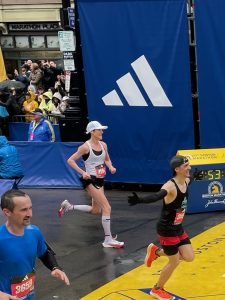
I finished smiling, happy, grateful, and unbelievably proud of what the human mind and body can accomplish with training and belief in ourselves. And, I finished with a Boston Marathon course PR.
Boston Marathon 2023: 2:52:14
Boston Marathon 2022: 2:56:56
Boston Marathon 2013: 3:28:53
Boston Marathon 2011: 3:25:30
There is not a doubt in my mind that the carb load + fueling early and often saved my race. Things happen. Perfect races are the unicorn, not the norm. But if we can stay mentally engaged, positive about our body’s performance, and focus on what we can control we can accomplish some pretty incredible things! Boston Marathon – I love you, forever and ever.
After the Finish Line
As I finished, the first person I saw was Ali Feller. I immediately walked over to her and said ‘I pooped twice.’ Apparently, I found immense comfort in sharing this with her. She then hugged the crap outta me, almost. Snagged this sweet finisher photo and they must have noticed the V on my bib and sent me right into the VIP tent where I saw my dear friend and medical volunteer, Tamanna. I got another massive hug – I can still feel her stethoscope in my chest.

I scooted through the VIP tent and out the back door in approximately 5 seconds as I grabbed a medal and saw my hotel across the street. I just wanted to get inside a warm hotel, shower, and let my family know I freaking did it!
After a very long shower, I met some people at the hotel bar to wait for the rest of our crew to finish. I slugged back a protein drink in the shower <shower shake!> + a couple of bottles of water. Your sports dietitian had ZERO interest in carbs at the moment but a glass of bourbon was on tap at the bar.
After everyone finished, we headed over to Joe’s on Newbury for burgers and fries – my favorite post-race meal. My mom still cannot believe I eat hamburgers <I was a very selective eater as a kid> so I sent her this picture as proof.

Lessons I Learned:
Every marathon is a learning experience. This is why we become better at running the marathon the longer we stick with it. We also know the marathon is a beast. We can do absolutely everything right and still not have a flawless race. My day is a great example of that – I did everything I always do, yet still had some GI trouble.
Carb Load is Queen. I cannot tell you how many times a carb load has saved my athletes and now me. If we fully load those glycogen stores pre-race, we can rely on these for FAST fuel throughout the entire race.
Fuel Early & Often. Again, we never know what the day will bring. If we fuel our body early & consistently we are less likely to hit the wall. And, much more likely to have a mentally strong race. Carbs make us positive, happy and optimistic when racing.
Keep Your Mental Game Strong. Those fumbles on race day don’t have to break our performance. But you know what might?! Our mental game. It’s easy to hear those negative thoughts and allow them to derail our performance. Focus on the positive facts – my body feels strong, I am happy, I am healthy, I am running the freaking Boston Marathon!
Know & Trust Your Body. We all need a plan going into a race. But, we need to listen to our bodies and adjust the plan on the fly when needed. Nothing is set in stone. Trust your body and adapt when needed.
Have Fun. We GET to do this! And, we do this in our free time!!! If this isn’t fun, then why would we do it?! Focus on why you enjoy this and have the time of your life.
Thank you!
I want to send out a huge thank you to Abbott for letting me join their team for the Boston Marathon, New Balance for creating the perfect Carb Load Boxes for 200 of our runners, ASICS for feeding over 500 runners all the bagels they needed & allowing us to take over their store for a shakeout run, Adidas for sponsoring our Fueled for Boston group nutrition class, Believe in the Run for being my trusty sidekicks in all things running, and to all of YOU for trusting me to be a part of your journey and sharing that journey with me.
All of Your Collagen Questions...Answered!
All of Your Collagen Questions...Answered!
In the previous post in this series, we went over the basics of collagen, clueing you in on how it can improve your joint health and injury recovery, which food and supplement sources are best, and how much to take and when. Now let’s bust some collagen myths, look at the latest varieties, and help you avoid the mistakes I often see runners and other athletes making.
Can I supplement collagen for my protein powder?
Quite a few clients have told me that they’ve started taking collagen instead of their regular protein supplement. The trouble with doing so is that unlike whey, it’s an incomplete protein, which means it doesn’t contain all nine amino acids that your body can’t produce on its own. Collagen is abundant in three aminos – glycine, proline, and hydroxyproline – but is low in branched-chain amino acids (BCAAs), like leucine, that is needed to stimulate muscle protein synthesis and doesn’t contain tryptophan. This is why it can complement a protein supplement but shouldn’t replace it. A study published in Nutrients suggested that you can count 36 percent of the protein in collagen toward your daily total <roughly one-third>, so if your supplement contains 20 grams per serving, that’s 7 grams to include in your macro count.
Are vegan collagen supplements legit?
While plant protein offers a viable alternative to whey, there’s no such thing as vegetarian or vegan collagen because it’s only found in animal flesh that contains connective tissue. In theory, your body can make collagen if provided with all the right building blocks, but supplemental, animal-based protein is what increases collagen synthesis most efficiently in humans. That being said, certain plant foods contain sources that assist in collagen production. Often marketed as “collagen boosters,” these can include amino acids like lysine, proline, and hydroxyproline, minerals such as copper, manganese, and zinc, and, as we mentioned earlier, vitamin C.
Is it true that I shouldn't mix collagen & coffee?
Recently, several collagen vendors have started recommending that you shouldn’t put their products in coffee, even though the hot liquid helps the powder dissolve. It’s true that one Polish study found while experimenting with human cells in a petri dish that caffeine inhibited collagen biosynthesis. However, it didn’t stop collagen uptake and because of a lack of human based research, there’s no evidence that the same thing would happen in your body. Other studies have only been conducted on rodents, and it’s unwise to try and project how or if they translate to humans. So for now, I believe it’s still effective to add collagen to your coffee, especially if that’s how you prefer your pre-run caffeine intake & need to take your collagen.
Are collagen gummies & creamers effective?
While powder remains the most popular kind of collagen supplement companies have begun offering other forms. Collagen gummies make it a little difficult to ingest enough collagen to meet the effective dose, as the per serving dose is usually lower than a scoop of powder, at around 2.5 grams per four gummies. This means you’d need to munch up 16 to get a clinically effective amount. Collagen creamers are handy for adding flavor and collagen to coffee or tea, but the same thing goes. As they typically provide five grams of collagen, you’ll need to double the serving size to get enough.
What's new & next in collagen supplementation?
Several companies are experimenting with genetically modified yeast and bacteria to produce lab-grown collagen that’s technically free of animal products, although this is still in the developmental phase and as it uses microbes, might not be truly vegan. A few companies are offering a new kind of collagen made from fermented eggshell membrane (the part between the shell and the white inside). It can be hard to tell how much actual collagen is in a proprietary blend that can also include prebiotics and probiotics, but two studies that tested its efficacy found that eggshell collagen supplementation reduced pain and increased flexibility after both seven and 30 days.
What are the most common mistakes athletes make with collagen supplements?
Timing: Taking it outside the recommended 45-to-60-minute window before exercise
Amount: Getting less than the 10 to 15 grams needed to stimulate collagen synthesis
Using as a protein supplement: Collagen is an incomplete protein and doesn’t contain enough leucine which is necessary for muscle protein synthesis.
What are some key takeaways when it comes to collagen?
To make the most of collagen’s injury-healing, joint health-promoting benefits, make sure you:
Complement collagen-rich foods with a supplement. Most people don’t get enough from their diet and studies suggest we could all benefit from 2.5 to 15 grams per day.
If you’re an aging athlete, suffer from joint pain/cartilage loss, or struggle with connective and soft tissue injuries, a collagen supplement from a trusted brand like Informed Sport or NSF Certified for Sport® may be beneficial.
Be consistent. Find a way to incorporate collagen regularly before you train.
Give it time. Most studies show it takes around six months to realize the full benefits of collagen supplementation.
For even more in-depth collagen info, check out episode 47 of the Fuel for the Sole podcast. Need help with choosing collagen, other supplements, and dialing in your nutrition? Reach out and let’s talk.
1.Cristiana Paul et al, “Significant Amounts of Functional Collagen Peptides Can Be Incorporated in the Diet While Maintaining Indispensable Amino Acid Balance,” Nutrients, May 2019, available online at https://www.ncbi.nlm.nih.gov/pmc/articles/PMC6566836. 2. Kevin J Ruff et al, “Eggshell Membrane: A Possible New Natural Therapeutic for Joint and Connective Tissue Disorders. Results from Two Open-Label Human Clinical Studies,” Clinical Interventions in Aging, June 2009, available online at https://www.ncbi.nlm.nih.gov/pmc/articles/PMC2697588. 3. Magdalena Donejko et al, “Influence of Caffeine and Hyaluronic Acid on Collagen Biosynthesis in Human Skin Fibroblasts,” Drug Design, Development, and Therapy, October 2014, available online at https://pubmed.ncbi.nlm.nih.gov/25342885.
Disclaimer: The content in our blog articles provides generalized nutrition guidance. The information above may not apply to everyone. For personalized recommendations, please reach out to your sports dietitian. Individuals who may chose to implement nutrition changes agree that Featherstone Nutrition is not responsible for any injury, damage or loss related to those changes or participation.
How Endurance Athletes Can Use Collagen Effectively
How Endurance Athletes Can Use Collagen Effectively
While energy gels, electrolytes, and protein are arguably still the three most popular supplements in the endurance community, the demand for collagen has surged over the past couple of years and, it’s now a $2 billion a year market. But while it can be useful, you might not be using collagen correctly. Let’s clear up any confusion over when it’s best to use collagen, what it’s not so good for, and how much to take.
What is collagen?
Collagen is the most abundant structural protein, comprising around a third of the total protein in the body. It’s a fiber-like structure that makes up connective tissue and is a major component of bone, skin, muscles, tendons, ligaments, and cartilage.
What's with all the hype around collagen?
Because collagen production and uptake both declines as we age – starting as early as your late 20s – it may be beneficial to start supplementing. Production drops more quickly with sun exposure (in the skin), smoking, excess alcohol, and lack of sleep and exercise. Research suggests we may benefit from supplementing collagen as you get older to support your training and recovery. Collagen also has the potential to enhance joint health and function, support injury recovery, and improve the appearance of hair, skin, and nails.
What are the types of collagen and which one should I take?
There are three types of collagen:
Type I – 90% of collagen in the body, including in bones, tendons, ligaments, and skin. It’s found in bovine collagen – which is the most common supplemental kind.
Type II – Mostly prevalent in cartilage, but a little is also in tendons and ligaments
Type III – Always found with Type I in skin and organs
There aren’t head-to-head studies comparing different kinds, but in a review, Keith Baar from the University of California Davis, noted that hydrolyzed collagen <when collagen peptides are partially broken down into amino acids> is the most bioavailable form.
What are the benefits of taking a collagen supplement?
Cartilage Regrowth
Tufts Medical Center researchers found that when they gave 30 people over 49 with knee osteoarthritis 10 grams of collagen or a placebo for 24 weeks, the ones who took collagen increased cartilage thickness and growth.
Joint Pain
A group of German nutritionists gave 139 active adults five grams of collagen daily for 12 weeks, and it reduced their knee pain. Another study conducted at Penn State involved 97 athletes taking 10 grams of collagen every day. After six months, they experienced less joint pain during activity.
Strengthened Ligaments and Tendons
Australian exercise scientists discovered that combining calf strengthening exercises with collagen supplementation for six months helped Achilles tendinopathy patients increase muscle strength and reduced discomfort. A paper released via the Journal of Sports Science & Medicine tested the ankle function of 50 male and female athletes with chronic ankle instability. After six months of collagen supplementation, they reported that their ankles felt more stable and had reduced their reinjury rates.
Bone Density in Postmenopausal Women
One hundred and two postmenopausal women participated in a study published in Nutrients. Following a year of taking five grams of collagen every day, they had greater bone mineral density, increased bone formation, and decreased degradation.
Skin Elasticity
A group of Japanese and Korean researchers concluded that taking just one gram of collagen consistently improved skin hydration and elasticity and reduced wrinkling.
What are the best food sources of collagen?
Bone broth: 1 cup has two to five grams of collagen, and the liquid form makes it easy to digest
Sardines or fish with the skin on: Marine collagen is found in the bones, scales, & skin
Gelatin: One packet of the Knox brand has 8 grams of gelatin. It has the same amino acid composition as collagen.
Chicken & turkey skin: It might not sound that appetizing, but poultry skin is a good source of collagen
What to take & when to take it
A collagen supplement can help you get a consistent dose of collagen without needing to prepare a food source. The optimal dose for most people is 10 to 15 grams, so pay attention to the serving size when comparing supplements.
And not all supplements are created equal, and there have been reports of low-grade options being contaminated with heavy metals and not containing what they claim on the label. So look for an option like Momentous Collagen Peptides, which contains 15 grams of collagen and 50 mg of vitamin C and is NSF Certified for Sport®, so it’s guaranteed to be free of contaminants and banned substances. It dissolves well in warm water, and you can add an electrolyte mix before exercise.
Research shows that collagen works most effectively when you take it 30 minutes to an hour before training or, if you’re injured, prior to physical therapy. A study published in The American Journal of Clinical Nutrition showed that jumping rope doubled participants’ collagen synthesis levels and when they took collagen with vitamin C an hour beforehand, it doubled again. Baar noted that when trying to increase the durability of ligaments and tendons, combining pre-workout collagen, 10 minutes or less of intense activity, and six hours or more of rest is an effective protocol.
Check back soon for part two, in which we’ll examine if vegan collagen is legit, whether you can mix coffee and collagen, and more!
1. Keith Baar, “Minimizing Injury and Maximizing Return to Play: Lessons from Engineered Ligaments,” Sports Medicine, 2017, available online at https://www.ncbi.nlm.nih.gov/pmc/articles/PMC5371618.m 2. T E McAlindon et al, “Change in Knee Osteoarthritis Cartilage Detected by Delayed Gadolinium Enhanced Magnetic Resonance Imaging Following Treatment with Collagen Hydrolysate: A Pilot Randomized Controlled Trial,” Osteoarthritis and Cartilage, April 2011, available online at https://pubmed.ncbi.nlm.nih.gov/21251991. 3.Denise Zdzieblik et al, “Corrigendum: Improvement of Activity-Related Knee Joint Discomfort Following Supplementation of Specific Collagen Peptides,” Applied Physiology, Nutrition, and Metabolism, November 2017, available online at https://pubmed.ncbi.nlm.nih.gov/29081241. 4. Kristine L Clark et al, “24-Week Study on the Use of Collagen Hydrolysate as a Dietary Supplement in Athletes with Activity-Related Joint Pain,” Current Medical Research and Opinion, May 2008, available online at https://pubmed.ncbi.nlm.nih.gov/18416885. 5.Stephan F E Praet et al, “Oral Supplementation of Specific Collagen Peptides Combined with Calf-Strengthening Exercises Enhances Function and Reduces Pain in Achilles Tendinopathy Patients,” Nutrients, January 2019, available online at https://pubmed.ncbi.nlm.nih.gov/30609761. 6.Patrick Dressler et al, “Improvement of Functional Ankle Properties Following Supplementation with Specific Collagen Peptides in Athletes with Chronic Ankle Instability,” Journal of Sports Science & Medicine, May 2018, available online at https://pubmed.ncbi.nlm.nih.gov/29769831. 7.Daniel König et al, “Specific Collagen Peptides Improve Bone Mineral Density and Bone Markers in Postmenopausal Women-A Randomized Controlled Study,” Nutrients, January 2018, available online at https://pubmed.ncbi.nlm.nih.gov/29337906. 8.Do-Un Kim et al, “Oral Intake of Low-Molecular-Weight Collagen Peptide Improves Hydration, Elasticity, and Wrinkling in Human Skin: A Randomized, Double-Blind, Placebo-Controlled Study,” Nutrients, June 2018, available online at https://pubmed.ncbi.nlm.nih.gov/29949889. 9.Gregory Shaw et al, “Vitamin C–Enriched Gelatin Supplementation Before Intermittent Activity Augments Collagen Synthesis,” The American Journal of Clinical Nutrition, November 2016, available online at https://www.ncbi.nlm.nih.gov/pmc/articles/PMC5183725.
Disclaimer: The content in our blog articles provides generalized nutrition guidance. The information above may not apply to everyone. For personalized recommendations, please reach out to your sports dietitian. Individuals who may chose to implement nutrition changes agree that Featherstone Nutrition is not responsible for any injury, damage or loss related to those changes or participation.


